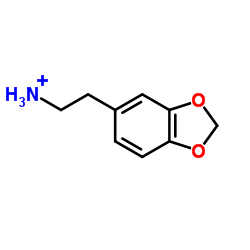Rat brain serotonin neurones that express neuronal nitric oxide synthase have increased sensitivity to the substituted amphetamine serotonin toxins 3,4-methylenedioxymethamphetamine and p-chloroamphetamine.
D J De Silva, S J French, N Y Cheung, A K Swinson, C Bendotti, M Rattray
Index: Neuroscience 134(4) , 1363-75, (2005)
Full Text: HTML
Abstract
Substituted amphetamines such as p-chloroamphetamine and the abused drug methylenedioxymethamphetamine cause selective destruction of serotonin axons in rats, by unknown mechanisms. Since some serotonin neurones also express neuronal nitric oxide synthase, which has been implicated in neurotoxicity, the present study was undertaken to determine whether nitric oxide synthase expressing serotonin neurones are selectively vulnerable to methylenedioxymethamphetamine or p-chloroamphetamine. Using double-labeling immunocytochemistry and double in situ hybridization for nitric oxide synthase and the serotonin transporter, it was confirmed that about two thirds of serotonergic cell bodies in the dorsal raphé nucleus expressed nitric oxide synthase, however few if any serotonin transporter immunoreactive axons in striatum expressed nitric oxide synthase at detectable levels. Methylenedioxymethamphetamine (30 mg/kg) or p-chloroamphetamine (2 x 10 mg/kg) was administered to Sprague-Dawley rats, and 7 days after drug administration there were modest decreases in the levels of serotonin transporter protein in frontal cortex, and striatum using Western blotting, even though axonal loss could be clearly seen by immunostaining. p-Chloroamphetamine or methylenedioxymethamphetamine administration did not alter the level of nitric oxide synthase in striatum or frontal cortex, determined by Western blotting. Analysis of serotonin neuronal cell bodies 7 days after p-chloroamphetamine treatment, revealed a net down-regulation of serotonin transporter mRNA levels, and a profound change in expression of nitric oxide synthase, with 33% of serotonin transporter mRNA positive cells containing nitric oxide synthase mRNA, compared with 65% in control animals. Altogether these results support the hypothesis that serotonin neurones which express nitric oxide synthase are most vulnerable to substituted amphetamine toxicity, supporting the concept that the selective vulnerability of serotonin neurones has a molecular basis.
Related Compounds
| Structure | Name/CAS No. | Molecular Formula | Articles |
|---|---|---|---|
 |
1,3-Benzodioxole-5-ethanamine,hydrochloride (1:1)
CAS:1653-64-1 |
C9H12NO2 |
|
Synthesis and antihypertensive activity of some thienylethan...
1976-07-01 [J. Med. Chem. 19(7) , 876-82, (1976)] |
|
An aryne route to laureline, and related topics. Gibson MS, ...
[J. Chem. Soc. Sect. C 16 , 2234-2238, (1970)] |
|
Determination of paramethoxyamphetamine and other amphetamin...
2002-01-01 [Rapid Commun. Mass Spectrom. 16(9) , 865-70, (2002)] |
|
Hypothalamic-pituitary-thyroid axis and sympathetic nervous ...
2003-04-01 [J. Pharmacol. Exp. Ther. 305(1) , 159-66, (2003)] |
|
Ecstasy analogues found in cacti.
2008-06-01 [J. Psychoactive Drugs 40(2) , 219-22, (2008)] |